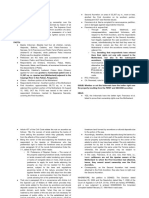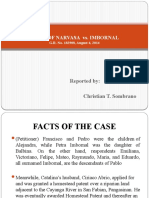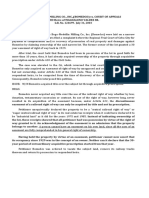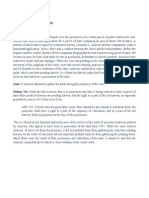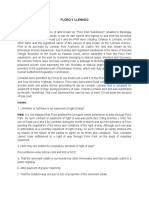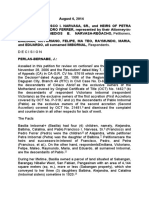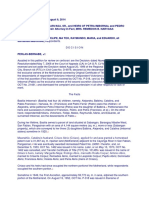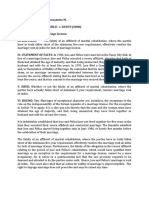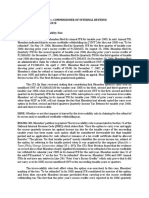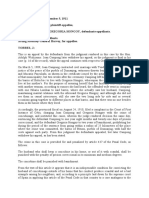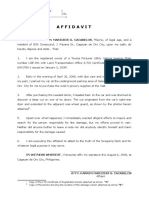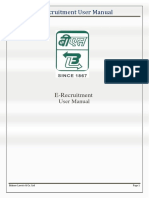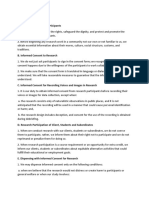Narvasa vs. Imbornal
Narvasa vs. Imbornal
Uploaded by
Bernadette RacadioCopyright:
Available Formats
Narvasa vs. Imbornal
Narvasa vs. Imbornal
Uploaded by
Bernadette RacadioOriginal Description:
Original Title
Copyright
Available Formats
Share this document
Did you find this document useful?
Is this content inappropriate?
Copyright:
Available Formats
Narvasa vs. Imbornal
Narvasa vs. Imbornal
Uploaded by
Bernadette RacadioCopyright:
Available Formats
Right of Accession
Racadio, Marie Bernadette M.
NARVASA VS. IMBORNAL (2014)
FACTS: Basilia Imbornal owned a parcel of land situated at Sabangan, Pangasinan which
she conveyed to her 3 daughters, Balbina, Alejandra, and Catalina sometime in 1920.
Meanwhile, Catalina’s husband, Ciriaco Abrio (Ciriaco), applied for and was granted a
homestead patent over a 31,367-sq. m. riparian land (Motherland) adjacent to the
Cayanga River in San Fabian, Pangasinan. Ciriaco and his heirs had since occupied the
northern portion of the Motherland, while respondents occupied the southern portion.
The First Accretion, adjoined the southern portion of the Motherland. OCT No. P-318 was
issued in the name of respondent Victoriano married to Esperanza Narvarte, covering the
First Accretion. The Second Accretion, abutted the First Accretion on its southern portion.
OCT No. 21481 was issued in the names of all the respondents covering the Second
Accretion.
ISSUE: Who are the owners of the first and second accretions?
Ruling: Being the owner of the land adjoining the foreshore area, respondent is the riparian
or littoral owner who has preferential right to lease the foreshore area. Accordingly,
therefore, alluvial deposits along the banks of a creek or a river do not form part of the
public domain as the alluvial property automatically belongs to the owner of the estate to
which it may have been added. The only restriction provided for by law is that the owner of
the adjoining property must register the same under the Torrens system; otherwise, the
alluvial property may be subject to acquisition through prescription by third persons.
In this case, Francisco, et al. and, now, their heirs, herein petitioners are not the riparian
owners of the Motherland to which the First Accretion had attached, hence, they cannot
assert ownership over the First Accretion. Consequently, as the Second Accretion had
merely attached to the First Accretion, they also have no right over the Second Accretion.
Neither were they able to show that they acquired these properties through prescription as
it was not established that they were in possession of any of them.
Therefore, whether through accretion or, independently, through prescription, the
discernible conclusion is that Francisco et al. and/or petitioners' claim of title over the First
and Second Accretions had not been substantiated, and, as a result, said properties cannot
be reconveyed in their favor. This is especially so since on the other end of the fray lie
respondents armed with a certificate of title in their names covering the First and Second
Accretions coupled with their possession thereof, both of which give rise to the superior
credibility of their own claim.
You might also like
- Operating Circular 1 AppendicesDocument6 pagesOperating Circular 1 Appendicespurpel100% (1)
- Narvasa v. ImbornalDocument2 pagesNarvasa v. ImbornalRenzoSantos67% (3)
- (LTD) (International Hardwood v. UP) (Luciano)Document3 pages(LTD) (International Hardwood v. UP) (Luciano)noel8938luciano100% (2)
- 10 Machinery & Engineering Supplies, Inc. v. CADocument2 pages10 Machinery & Engineering Supplies, Inc. v. CADana HernandezNo ratings yet
- 1215 Notice of Claim of Right ExampleDocument3 pages1215 Notice of Claim of Right ExampleTitle IV-D Man with a plan100% (4)
- Corruption Is A Big Menace in PakistanDocument7 pagesCorruption Is A Big Menace in PakistanIrfan Baloch100% (1)
- Heirs of Narvasa Vs ImbornalDocument9 pagesHeirs of Narvasa Vs ImbornalCj NightsirkNo ratings yet
- Andres Vs Sta Lucia SaireeDocument2 pagesAndres Vs Sta Lucia Saireecute_treeena5326No ratings yet
- De Vera vs. Mayandoc - Case DigestDocument1 pageDe Vera vs. Mayandoc - Case DigestKristine Bernadette Cruz100% (2)
- GR No. 152423 (2010) - Sps Esmaquel V CopradaDocument2 pagesGR No. 152423 (2010) - Sps Esmaquel V CopradaNikki Estores GonzalesNo ratings yet
- Catedrilla v. LauronDocument2 pagesCatedrilla v. LauronChristian Roque100% (1)
- Digest Dept. of Education vs. TuliaoDocument1 pageDigest Dept. of Education vs. TuliaoClioNo ratings yet
- Property Cases DigestDocument3 pagesProperty Cases DigestWilton Norman Jvmantoc100% (1)
- 2012 - Galang Vs Reyes, GR No. 184746 August 15, 2012Document2 pages2012 - Galang Vs Reyes, GR No. 184746 August 15, 2012Lyka Lim Pascua100% (2)
- Case #1 BOMEDCO Vs CA EasementDocument1 pageCase #1 BOMEDCO Vs CA EasementailynvdsNo ratings yet
- METROPOLITAN WATERWORKS AND SEWERAGE SYSTEM Vs CADocument2 pagesMETROPOLITAN WATERWORKS AND SEWERAGE SYSTEM Vs CAmark anthony mansuetoNo ratings yet
- 15 Dominador Apique v. Fahnestich, G.R. No. 205705, August 5, 2015Document1 page15 Dominador Apique v. Fahnestich, G.R. No. 205705, August 5, 2015mark anthony mansuetoNo ratings yet
- Isaguirre vs. de LaraDocument3 pagesIsaguirre vs. de LaraRAINBOW AVALANCHENo ratings yet
- Azarcon Vs EusebioDocument1 pageAzarcon Vs EusebioEdcar LatauanNo ratings yet
- Edwin Case v. Heirs of TuasonDocument1 pageEdwin Case v. Heirs of TuasonCourtney Tirol100% (2)
- Bustos v. Court of Appeals, G.R. No. 120784-85, January 24, 2001Document1 pageBustos v. Court of Appeals, G.R. No. 120784-85, January 24, 2001mark anthony mansueto100% (1)
- Viajar Vs CADocument2 pagesViajar Vs CAEumir Songcuya100% (2)
- Floro V Llenado Quimen V CADocument3 pagesFloro V Llenado Quimen V CACla BA100% (1)
- Catedrilla V Lauron PDFDocument2 pagesCatedrilla V Lauron PDFbobNo ratings yet
- Dizon vs. Suntay G.R. No. L-30817, September 29, 1972, 47 SCRA 160Document3 pagesDizon vs. Suntay G.R. No. L-30817, September 29, 1972, 47 SCRA 160Ceslhee AngelesNo ratings yet
- Briones v. Macabagdal (G.R. No. 150666, August 3, 2010)Document2 pagesBriones v. Macabagdal (G.R. No. 150666, August 3, 2010)Lorie Jean UdarbeNo ratings yet
- 11 Aurora Del Banco v. Intermediate Appellate Court 156 SCRA 55 No L-72694 December 1, 1987Document1 page11 Aurora Del Banco v. Intermediate Appellate Court 156 SCRA 55 No L-72694 December 1, 1987mark anthony mansuetoNo ratings yet
- Cebu Oxygen & Acetylene, Inc Vs Hon. Pascual Bercilles, 66 SCRA 481Document1 pageCebu Oxygen & Acetylene, Inc Vs Hon. Pascual Bercilles, 66 SCRA 481Archibald Jose Tiago Manansala100% (1)
- People V PletchaDocument2 pagesPeople V PletcharaykarloB67% (3)
- Spouses Aguino v. Spouses AguilarDocument2 pagesSpouses Aguino v. Spouses AguilarChristian Roque100% (4)
- Case Digest Sulo Sa Nayon Vs Nayong PilipinoDocument2 pagesCase Digest Sulo Sa Nayon Vs Nayong PilipinoDivina Gracia Hinlo100% (1)
- Azarcon Vs EusebioDocument1 pageAzarcon Vs EusebioKling KingNo ratings yet
- Green Acres Holdings v. CabralDocument4 pagesGreen Acres Holdings v. CabralKiethe MyraNo ratings yet
- 168 Scra 405Document1 page168 Scra 405Ray Adrian P. DitonaNo ratings yet
- Tan-Yap v. Judge PatricioDocument3 pagesTan-Yap v. Judge PatricioChristine LaguraNo ratings yet
- Choco Vs Santamaria 21 Phil 132Document2 pagesChoco Vs Santamaria 21 Phil 132Charles Gerard B. BeluanNo ratings yet
- Calimoso Et. Al. V Roullo Case DigestDocument1 pageCalimoso Et. Al. V Roullo Case DigestMara ClaraNo ratings yet
- Salazar V Gutierrez Case DigestDocument2 pagesSalazar V Gutierrez Case Digestsuigeneris28100% (3)
- Pacific Farms Inc Vs Esguerra 30 Scra 684Document13 pagesPacific Farms Inc Vs Esguerra 30 Scra 684Che Poblete Cardenas100% (2)
- Rodriguez v. CA, G.R. No. 142687Document2 pagesRodriguez v. CA, G.R. No. 142687rhodz 88No ratings yet
- Board of Assessment Appeals v. Samar Mining Co.Document3 pagesBoard of Assessment Appeals v. Samar Mining Co.Anit EmersonNo ratings yet
- 02 Goldcrest v. CypressDocument2 pages02 Goldcrest v. Cypresspdasilva100% (1)
- 113 Department of Education v. Casibang G.R. No. 192268 January 27 2016Document2 pages113 Department of Education v. Casibang G.R. No. 192268 January 27 2016Ronald Alasa-as Atig100% (3)
- Agustin v. IAC (Digest)Document2 pagesAgustin v. IAC (Digest)Tini Guanio100% (2)
- Green Acres Holdings, Inc. v. Cabral PDFDocument3 pagesGreen Acres Holdings, Inc. v. Cabral PDFJaime Añonuevo Jr.100% (1)
- 309 Fabie v. David, 75 Phil 536Document2 pages309 Fabie v. David, 75 Phil 536Mik ZeidNo ratings yet
- Pacific Farm Vs EsguerraDocument1 pagePacific Farm Vs EsguerraJewel Ivy Balabag DumapiasNo ratings yet
- Credit Pacific Farms Vs EsguerraDocument2 pagesCredit Pacific Farms Vs Esguerramichelle zatarainNo ratings yet
- 35 - Manotok Realty, Inc. vs. TecsonDocument1 page35 - Manotok Realty, Inc. vs. Tecsonmay_alili67% (3)
- Notes:: VDA DE ALBAR v. CARANDANG, 106 PHIL 855-UsufructDocument8 pagesNotes:: VDA DE ALBAR v. CARANDANG, 106 PHIL 855-UsufructMaricris Mariano Villegas100% (1)
- Green Acres V CabralDocument2 pagesGreen Acres V CabralJudy RiveraNo ratings yet
- 2012 - Communities Cagayan Incorporated Vs Nanol, GR 176791, November 14, 2012Document1 page2012 - Communities Cagayan Incorporated Vs Nanol, GR 176791, November 14, 2012Lyka Lim Pascua100% (1)
- Sps. Salvador v. Sps. Rabaja, G.R. No. 199990, February 04, 2015Document7 pagesSps. Salvador v. Sps. Rabaja, G.R. No. 199990, February 04, 2015Nalupa Jemma LynNo ratings yet
- SPA. DE LA CRUZ v. RAMISCALDocument1 pageSPA. DE LA CRUZ v. RAMISCALMacy TangNo ratings yet
- Tomas Claudio vs. CADocument1 pageTomas Claudio vs. CAmaryNo ratings yet
- Heirs of NarvasaDocument2 pagesHeirs of NarvasaIvan ArchilleNo ratings yet
- Accession Natural 2Document12 pagesAccession Natural 2catherine mallariNo ratings yet
- Property Digest Pool: Pool Of: Bae, Escarcha, Fernandez, Lapuz, Mariano, Novales, Paghunasan, TanaDocument3 pagesProperty Digest Pool: Pool Of: Bae, Escarcha, Fernandez, Lapuz, Mariano, Novales, Paghunasan, TanaEMELYNo ratings yet
- Heirs of Francisco I Narvasa SR Et Al Vs Emiliana Imbornal Et AlDocument10 pagesHeirs of Francisco I Narvasa SR Et Al Vs Emiliana Imbornal Et AlJuan TañamorNo ratings yet
- NAVASA Vs IMBORNALDocument11 pagesNAVASA Vs IMBORNALMaria Michelle MoracaNo ratings yet
- GR 182908Document7 pagesGR 182908Niehr RheinNo ratings yet
- Case Digest - Week 6Document18 pagesCase Digest - Week 6Van John MagallanesNo ratings yet
- Case Digest - Week 6Document28 pagesCase Digest - Week 6Van John MagallanesNo ratings yet
- Republic v. DayotDocument1 pageRepublic v. DayotBernadette RacadioNo ratings yet
- HOMEOWNERS ASSOCIATION OF TALAYAN VILLAGE INC. v. J.M. TUASONDocument2 pagesHOMEOWNERS ASSOCIATION OF TALAYAN VILLAGE INC. v. J.M. TUASONBernadette RacadioNo ratings yet
- Pajarillo vs. IacDocument1 pagePajarillo vs. IacBernadette RacadioNo ratings yet
- Rhombus Energy v. CIRDocument2 pagesRhombus Energy v. CIRBernadette RacadioNo ratings yet
- Orbeta V SendiongDocument19 pagesOrbeta V SendiongBernadette RacadioNo ratings yet
- Marubeni Philippines Corporation V. Commissioner of Internal RevenueDocument1 pageMarubeni Philippines Corporation V. Commissioner of Internal RevenueBernadette RacadioNo ratings yet
- DigestsDocument10 pagesDigestsBernadette RacadioNo ratings yet
- Cases ConcubinageDocument32 pagesCases ConcubinageBernadette RacadioNo ratings yet
- Digests in TaxDocument7 pagesDigests in TaxBernadette RacadioNo ratings yet
- Art.654-658 PropertyDocument16 pagesArt.654-658 PropertyBernadette RacadioNo ratings yet
- LBC Air Cargo vs. CADocument2 pagesLBC Air Cargo vs. CABernadette RacadioNo ratings yet
- Woodrow Wilson - 14 PointsDocument6 pagesWoodrow Wilson - 14 PointsLasko AmelieNo ratings yet
- June 29, 2016 G.R. No. 210858 Department of Foreign Affairs, Petitioner, Bca International Corporation, Respondent. Decision Carpio, J.: The CaseDocument10 pagesJune 29, 2016 G.R. No. 210858 Department of Foreign Affairs, Petitioner, Bca International Corporation, Respondent. Decision Carpio, J.: The CaseSeonoNo ratings yet
- Uk Prison StatsDocument26 pagesUk Prison StatsLuna RoseNo ratings yet
- Doctrine of Promissory Estoppel and Legitimate ExpectationDocument7 pagesDoctrine of Promissory Estoppel and Legitimate ExpectationsidhiNo ratings yet
- The City University of New York York College 94-20 Guy R. Brewer BLVD - Jamaica, NY 11451 - Telephone (718) 262-2165 - Fax (718) 262-2601Document7 pagesThe City University of New York York College 94-20 Guy R. Brewer BLVD - Jamaica, NY 11451 - Telephone (718) 262-2165 - Fax (718) 262-2601Jason HogueNo ratings yet
- Affidavit - Car DamageDocument2 pagesAffidavit - Car DamageKarren Cacabelos SurNo ratings yet
- ULEMAS-KAHOUL - لونيسي - تداعيات اغتيال المفتي كحول بن دالي على جمعية العلماء المسلمين الجزائريين والمؤتمر الإسلامي الجزائري - 26-12-2019 - المجلة الجزائرية للبحوث والدراسات التاريخية المتوسطيةDocument28 pagesULEMAS-KAHOUL - لونيسي - تداعيات اغتيال المفتي كحول بن دالي على جمعية العلماء المسلمين الجزائريين والمؤتمر الإسلامي الجزائري - 26-12-2019 - المجلة الجزائرية للبحوث والدراسات التاريخية المتوسطيةهشام بن يحيىNo ratings yet
- 2-G.R. No. 105827 - J.L. Bernardo Construction v. Court of AppealsDocument13 pages2-G.R. No. 105827 - J.L. Bernardo Construction v. Court of AppealsPat EspinozaNo ratings yet
- Classification of BanksDocument2 pagesClassification of Banksalexisvictoria.peraltaNo ratings yet
- Hydraulic Cement ConcreteDocument2 pagesHydraulic Cement Concretemonx1eNo ratings yet
- Venture CapitalDocument10 pagesVenture CapitalgalatimeNo ratings yet
- Principles of Managerial Finance 15th Edition Zutter Test BankDocument35 pagesPrinciples of Managerial Finance 15th Edition Zutter Test Bankdemivoltnotpatedf6u2ra100% (34)
- Hollier v. Rambler Motors AMC LTD (1972)Document5 pagesHollier v. Rambler Motors AMC LTD (1972)Saurabh MisalNo ratings yet
- David K. Bernard A History of Christian Doctrine Volume 2, The Reformation To The Holiness Movement A. D. 1500-1900 1995Document334 pagesDavid K. Bernard A History of Christian Doctrine Volume 2, The Reformation To The Holiness Movement A. D. 1500-1900 1995aasanasan100% (2)
- RPD 4-9-24Document4 pagesRPD 4-9-24PostBulltinDocsNo ratings yet
- E-Recruitment User ManualDocument16 pagesE-Recruitment User Manualdreampedlar_45876997No ratings yet
- A. Rights and Dignity of ParticipantsDocument4 pagesA. Rights and Dignity of ParticipantsJoshua NolascoNo ratings yet
- AIIMS Bilaspur Senior Nursing Officer Recruitment 2023 Notification PDFDocument30 pagesAIIMS Bilaspur Senior Nursing Officer Recruitment 2023 Notification PDFAshyana SaeedNo ratings yet
- Knowledge Bank - Advances Against DepositsDocument4 pagesKnowledge Bank - Advances Against DepositsKajeev KumarNo ratings yet
- Age of Succession Six Wives of Henry The VIIIDocument10 pagesAge of Succession Six Wives of Henry The VIIILejlaNo ratings yet
- Medco Credit Account Application Form and TCs DDocument2 pagesMedco Credit Account Application Form and TCs DA-Class1 PhotogNo ratings yet
- Contract Labour Amendment-MaharashtraDocument2 pagesContract Labour Amendment-MaharashtraManish ShahNo ratings yet
- UK Position PaperDocument1 pageUK Position PaperMuhammad ChohanNo ratings yet
- FIN201 Final Term PaperDocument26 pagesFIN201 Final Term PaperAsh ShafiNo ratings yet
- Estimated Out-of-Pocket Expenses: Mississippi State University Travel Advance RequestDocument1 pageEstimated Out-of-Pocket Expenses: Mississippi State University Travel Advance Requestuthmankheil89No ratings yet
- IR Bore PilingDocument3 pagesIR Bore PilingalfredoNo ratings yet
- Audit All Past Suggested Paper ICANDocument280 pagesAudit All Past Suggested Paper ICANMichael AdhikariNo ratings yet

